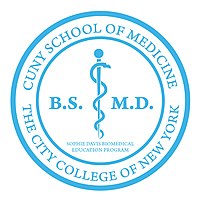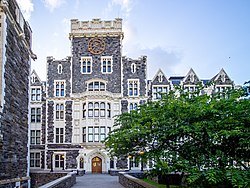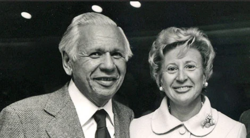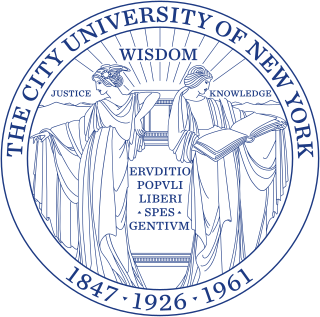
The City University of New York is the public university system of New York City. It is the largest urban university system in the United States, comprising 25 campuses: eleven senior colleges, seven community colleges, and seven professional institutions. In 1960, John R. Everett became the first chancellor of the Municipal College System of New York City, later known as the City University of New York (CUNY). CUNY, established by New York State legislation in 1961 and signed into law by Governor Nelson Rockefeller, was an amalgamation of existing institutions and a new graduate school.
The Albert Einstein College of Medicine is a private medical school in New York City. Founded in 1953, Einstein operates as an independent degree-granting institution as part of the integrated healthcare Montefiore Health System and also has affiliations with Jacobi Medical Center and Yeshiva University.

New York Medical College is a private medical school in Valhalla, New York. Founded in 1860, it is a member of the Touro University System.

The Warren Alpert Medical School is the medical school of Brown University, located in Providence, Rhode Island. Originally established in 1811, it was the third medical school to be founded in New England after only Harvard and Dartmouth. However, the original program was suspended in 1827, and the four-year medical program was re-established almost 150 years later in 1972, granting the first MD degrees in 1975.
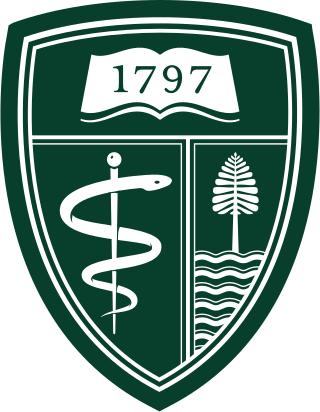
The Geisel School of Medicine at Dartmouth is the graduate medical school of Dartmouth College in Hanover, New Hampshire. The fourth oldest medical school in the United States, it was founded in 1797 by New England physician Nathan Smith. It is one of the seven Ivy League medical schools.

SUNY Downstate Health Sciences University is a public medical school and hospital in Brooklyn, New York. It is the southernmost member of the State University of New York (SUNY) system and the only academic medical center for health education, research, and patient care serving Brooklyn's 2.5 million residents. As of Fall 2018, it had a total student body of 1,846 and approximately 8,000 faculty and staff.
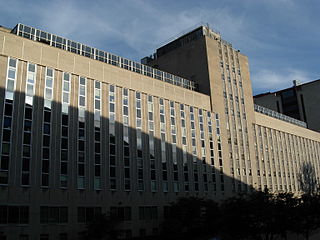
The University of Pittsburgh School of Medicine is a medical school of the University of Pittsburgh, located in Pittsburgh, Pennsylvania. The School of Medicine, also known as Pitt Med, encompasses both a medical program, offering the doctor of medicine, and graduate programs, offering doctor of philosophy and master's degrees in several areas of biomedical science, clinical research, medical education, and medical informatics.
Drexel University College of Medicine is the medical school of Drexel University, a private research university in Philadelphia, Pennsylvania. The medical school represents the consolidation of two medical schools: Hahnemann Medical College, originally founded as the nation's first college of homeopathy, and the Woman's Medical College of Pennsylvania, the first U.S. medical school for women, which became the Medical College of Pennsylvania when it admitted men in 1970; these institutions merged in 1993, became affiliated with Drexel University College of Medicine in 1998, and were fully absorbed into the university in 2002. With one of the nation's largest enrollments for a private medical school, Drexel University College of Medicine is the second most applied-to medical school in the United States. It is ranked no. 83 in research by U.S. News & World Report.

The City College of the City University of New York is a public research university within the City University of New York (CUNY) system in New York City. Founded in 1847, City College was the first free public institution of higher education in the United States. It is the oldest of CUNY's 25 institutions of higher learning and is considered its flagship institution.
Medical school in the United States is a graduate program with the purpose of educating physicians in the undifferentiated field of medicine. Such schools provide a major part of the medical education in the United States. Most medical schools in the US confer upon graduates a Doctor of Medicine (MD) degree, while some confer a Doctor of Osteopathic Medicine (DO) degree. Most schools follow a similar pattern of education, with two years of classroom and laboratory based education, followed by two years of clinical rotations in a teaching hospital where students see patients in a variety of specialties. After completion, graduates must complete a residency before becoming licensed to practice medicine.
The University of Arizona College of Medicine – Tucson, located in Tucson, Arizona, is one of three MD granting medical schools in the state of Arizona, affiliated with the University of Arizona. The University of Arizona College of Medicine – Phoenix was initially established as a branch campus in 2007, but became an independent medical school in 2012. The College of Medicine – Tucson campus is located at the University of Arizona Health Sciences (UAHS) center on the campus of the University of Arizona and is governed by the Arizona Board of Regents. Traditionally, the college accepted Arizona residents exclusively. However, beginning the 2009–2010 incoming class, the school changed its policy to allow for admission of "highly-qualified," non-residents.

The Touro College of Osteopathic Medicine (TouroCOM) is a private medical school with a main campus in the neighborhood of Central Harlem in New York City and additional campuses in Middletown, New York and Great Falls, Montana. It is a division of the Touro College and University System.
Geisinger Commonwealth School of Medicine (GCSOM) is a private medical school associated with the Geisinger Health System in northeastern and north central Pennsylvania. GCSOM offers a community-based model of medical education with six regional campuses - North, South, Central, West, Atlanticare, and Guthrie. It offers a Doctor of Medicine (MD) Program and a Master of Biomedical Sciences (MBS) Program.
The University of Connecticut School of Medicine is a medical school located in Farmington, Connecticut. It was founded in 1961, enrolled students in 1968, and graduated its first class in 1972.

Lisa Staiano-Coico or Lisa S. Coico is an American academic. Coico was the twelfth president of City College of New York, from August 2010 until October 2016.

The Texas Tech University Health Sciences Center School of Medicine is the medical school of Texas Tech University Health Sciences Center (TTUHSC). TTUHSC SOM was originally chartered in 1969 to train more physicians for the underserved populations of the West Texas region. As of 2011, the School of Medicine has awarded over 4,000 Doctor of Medicine degrees. The school offers the traditional four-year curriculum, as well as an accelerated three-year track, and joint degree programs with Texas Tech University.

The Renaissance School of Medicine (RSOM) is the graduate medical school of Stony Brook University located in the hamlet of Stony Brook, New York on Long Island. Founded in 1971, RSOM is consistently ranked the top public medical school in New York according to U.S. News & World Report. RSOM is one of the five Health Sciences schools under the Stony Brook Medicine healthcare system.

Sheldon Weinbaum: is an American biomedical engineer and biofluid mechanician. He is a CUNY Distinguished Professor Emeritus of Biomedical and Mechanical Engineering at The City College of New York. He is a member of all three U.S. national academies and also the American Academy of Arts and Sciences. In 2002 when he was elected to NAM he became the sixth living individual to be a member of all three National Academies and the first to achieve this distinction since 1992. He was the founding director (1994–1999) of the New York Center for Biomedical Engineering, a regional research consortium involving the BME program at The City College and eight of the premier health care institutions in New York City. He has been a lifelong advocate for women and minorities in science and engineering. He was the lead plaintiff and organizer of a class-action lawsuit charging New York State officials with racially discriminatory funding of its two university systems, CUNY and SUNY, the first CUNY faculty recipient of the Public Service Award of the Fund for the City of New York, and the Inaugural Recipient of the “Diversity Award” of the Biomedical Engineering Society (2009). He was the inaugural chair of the Selection Committee that chooses the annual Sloan Awardees for the outstanding math and science teachers in the New York City public high schools and served in this position from 2009 to 2019. In 2022 he received the Benjamin Franklin Medal in Biomedical Engineerings from the Franklin Institute in Philadelphia. In 2023 he received the National Medal of Science from President Biden.
Thomas Henry Haines was an American author, social activist, biochemist and academic. He was a professor of chemistry at City College of New York and of Biochemistry at the Sophie Davis School of Biomedical Education. He was a visiting professor in the Laboratory of Thomas Sakmar at Rockefeller University. He also served on the board of the Graham School, a social services and foster care agency in New York City. His scientific research focused on the structure and function of the living cell membrane. He is the father of Avril Haines, the seventh Director of National Intelligence.

California Health Sciences University (CHSU) is a private, for-profit university located in Clovis, California. Founded in 2012, the school operates three academic programs, two of which offer doctoral degrees (in pharmacy and osteopathic medicine), and the third offers a masters degree in science. Graduates of the College of Pharmacy (COP) will receive the Doctor of Pharmacy (Pharm D) degree, graduates of the College of Osteopathic Medicine (COM) will receive the Doctor of Osteopathic Medicine (DO) degree, and graduates of the College of Biosciences and Health Professions (CBHP) will receive the Masters of Science in Biomedical Sciences (MSBS) degree.
